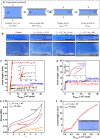Role of hierarchy structure on the mechanical adaptation of self-healing hydrogels under cyclic stretching
- PMID: 38117876
- PMCID: PMC10732516
- DOI: 10.1126/sciadv.adj6856
Role of hierarchy structure on the mechanical adaptation of self-healing hydrogels under cyclic stretching
Abstract
Soft materials with mechanical adaptability have substantial potential for various applications in tissue engineering. Gaining a deep understanding of the structural evolution and adaptation dynamics of soft materials subjected to cyclic stretching gives insight into developing mechanically adaptive materials. Here, we investigate the effect of hierarchy structure on the mechanical adaptation of self-healing hydrogels under cyclic stretching training. A polyampholyte hydrogel, composed of hierarchical structures including ionic bonds, transient and permanent polymer networks, and bicontinuous hard/soft-phase networks, is adopted as a model. Conditions for effective training, mild overtraining, and fatal overtraining are demonstrated in soft materials. We further reveal that mesoscale hard/soft-phase networks dominate the long-term memory effect of training and play a crucial role in the asymmetric dynamics of compliance changes and the symmetric dynamics of hydrogel shape evolution. Our findings provide insights into the design of hierarchical structures for adaptive soft materials.
Figures




References
-
- M. P. McHugh, C. H. Cosgrave, To stretch or not to stretch: The role of stretching in injury prevention and performance. Scand. J. Med. Sci. Sports 20, 169–181 (2010). - PubMed
-
- I. Mujika, S. Padilla, Detraining: Loss of training-induced physiological and performance adaptations. Part II: Long term insufficient training stimulus. Sports Med. 30, 145–154 (2000). - PubMed
-
- I. Mujika, S. Padilla, Detraining: Loss of training-induced physiological and performance adaptations. Part I: Short term insufficient training stimulus. Sports Med. 30, 79–87 (2000). - PubMed
-
- L. L. Smith, Tissue trauma: The underlying cause of overtraining syndrome? J. Strength Cond. Res. 18, 185–193 (2004). - PubMed
LinkOut - more resources
Full Text Sources

